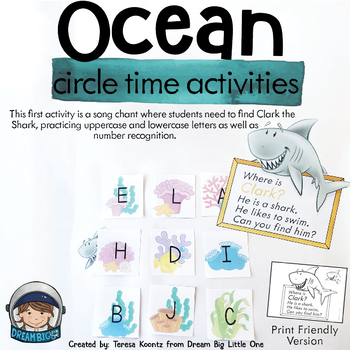Ocean Animal Circle Time Activities for Preschool and Kindergarten
- PDF
Also included in
- This bundle is made up of 15 fun ocean themed activities that develop fine motor (cutting, playdough, tracing), gross motor, math (counting objects, sorting by size, and number recognition), literacy (upper/lowercase recognition, prewriting skills, beginning sounds, basic print concepts and vocabulaPrice $12.25Original Price $24.25Save $12.00
Description
This ocean themed resource is made up of four circle time activities (mostly sharks) that practice uppercase letter, lowercase letter, numbers, colors and shape recognition, life science skills with shark facts, and positional words.
There are print friendly versions of each.
Great to use for Ocean theme, Shark Week theme or Aquarium theme.
Setup:
These activities have minimal setup.
Decide which activity printables you plan to use, print, laminate and cut.
These activities are meant to do during circle/large group time but the all can be done in small group time as well.
Here is an overview of each activity:
Where is Clark? Song Chant Activity with Numbers & Letters
This activity students have to find Clark the shark by singing a chant and choosing a letter or number tile that he can be hidden under. The chant goes, “Where is Clark? He is a shark. He likes to swim. Can you find him?” In this activity students can learn or reinforce number recognition, uppercase, and lowercase letters. The activity can be customized to focus on one particular skill. For example, you may want to only focus on letters and numbers your students have already learned and you can do that with this activity.
What is True About Sharks
In this activity, you and your students will decide if the statements regarding sharks are true or false. There are labels for a “True” column and a “False” column. Each statement is on a shark graphic.
Sorting Sharks by Length
In this activity, you and your students will describe sharks by using vocabulary with measurable attributes like “long” and “short.” You will then go on and sort the sharks by size using positional words like “above” and “below,” practicing math and literacy skills while learning interesting facts about sharks.
I Have/Who Has?
In this activity students learn and practice colors and 2D shapes (Square, circle, oval, rectangle, triangle, heart, star, rhombus, and crescent. The advanced set includes: octagon, pentagon, hexagon, and trapezoid). Each student is given a card that states with visual instructions, “I have a red circle. Who has an orange crescent?” The student with the orange crescent will read their card and the game will continue on until all of the students have had a turn.
Skills/Standards practiced:
This activity is designed to align with the Preschool Foundational and Kindergarten Readiness Standards used in my state, which are:
CC.2.4.c I can understand that each number name in sequence 0–10 means one more.
CC.3.7 I can associate quantities with written numerals 1–10.
RF.1d I can recognize some alphabet letters.
SL.6 I can speak clearly so that people can understand me
CA.1.1 I can use voice and instruments to create sound
CA 1.1a I can participate in music activities such as listening, singing, or performing.
L.2a I can recognize that there are upper and lower case letters.
CA 1.3b I can recognize and name colors (e.g., red, orange, yellow, green, blue, purple, black, white, brown)
G.1.1 I can tell you the shape of an object.
G.1.2 I can correctly name shapes.
RI.1 I can ask and answer questions about things I learn while reading.
SL.1 I can engage in conversations with peers and adults in small and larger groups, by talking about pictures, topics, and text.
SL.1b I can take multiple turns during conversations.
SL.6 I can speak clearly so that people can understand me
L.1d I can respond to and ask questions (e.g., who, what, where, when, why, and how).
L.6 I can use language that I have learned in class
SE/SS.2.1 I can develop skills to interact cooperatively with others.
SE/SS 2.1a I can engage in learning activities with peers.
SE/SS 2.1b I can respond to and interact with other children and adults in a formal or group setting.
SE/SS 2.1c I can participate cooperatively in a group
SE/SS 2.2a I can engage in behavior such as helping, sharing, and taking turns.
MD.1.1 I can describe objects using vocabulary specific to measure attributes (e.g., length [long/short], weight [heavy/light], size [big/small], and distance [near/far])
MD.1.2 I can compare objects using measurable attributes (e.g., length [longer/shorter], weight [heavier/lighter], and size [bigger/smaller]).
L.5b I can compare commonalities and differences by identifying opposites using descriptive words (e.g., big/little, short/long, large/small, happy/sad).
Students will gain an understanding of life science by:
1. Actively exploring living things.
2. Asking questions to gain further information about living things.
3. Collecting information about living things.
What you get
- Directions on how to use
- True/False Labels with 4 false statements about sharks and 4 true statements about sharks (color and print friendly)
- Sharks are Diverse poster with 7 shark graphics of various sizes, scuba diver and a car to sort (color and print friendly)
- 28 unique "I have/Who has?" shape cards (color and print friendly)
- "Where is Clark" Song chant poster, with uppercase letter tiles, lower case letter tiles, upper and lowercase together tiles, and number tiles (color and print friendly)
I love followers!
Get first access to store discounts, free products and product launches.
Click the green “Follow Me” star under my store name on this page or click the red “Follow Me” star on my store homepage.
Thank you,
Teresa from Dream Big Little One






